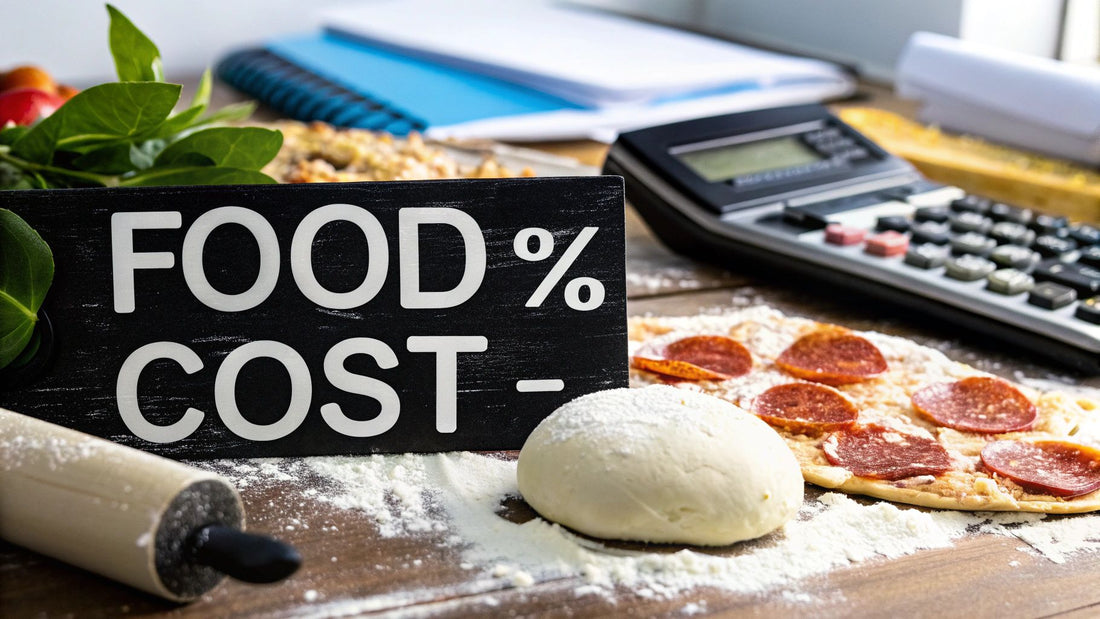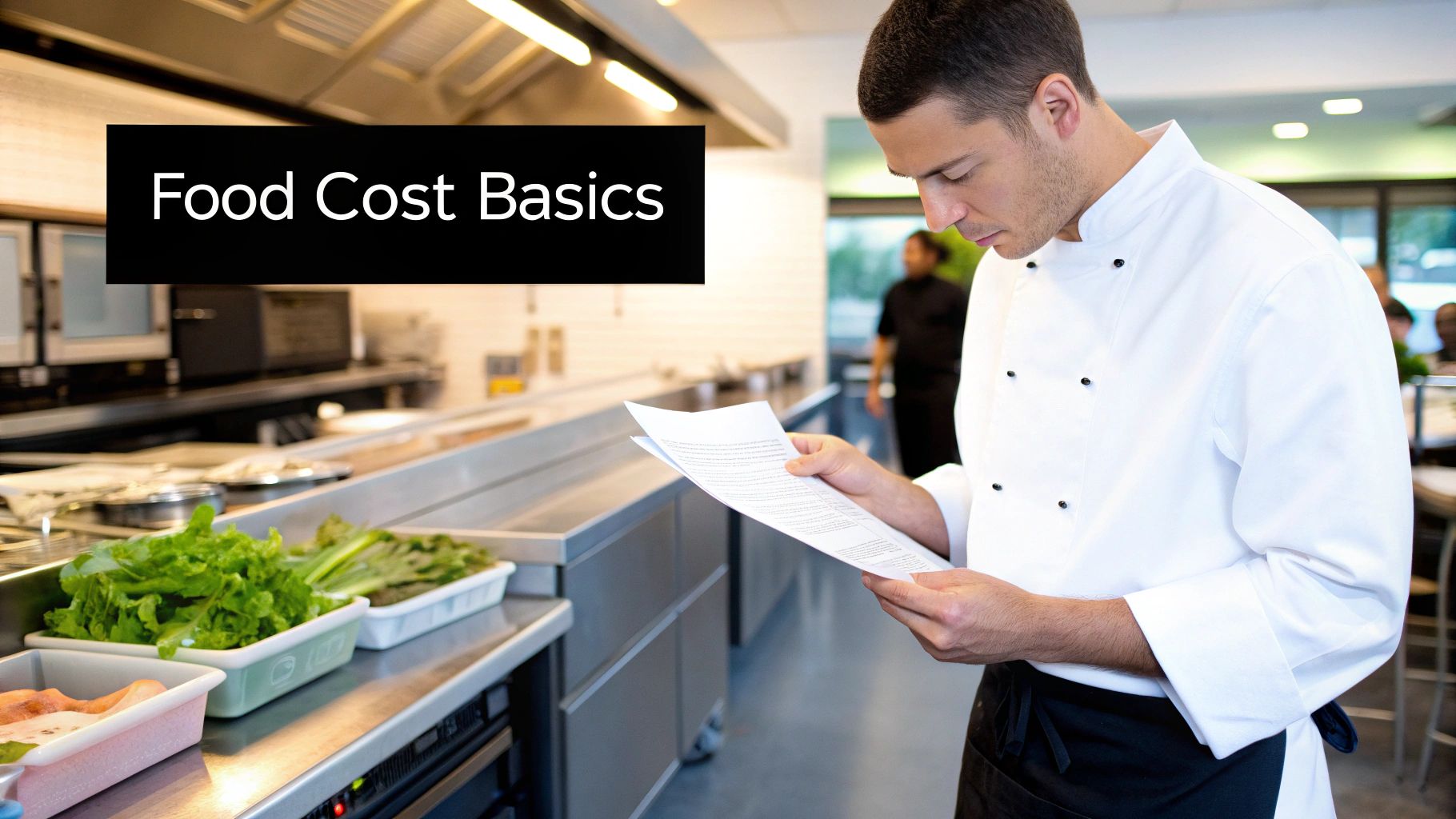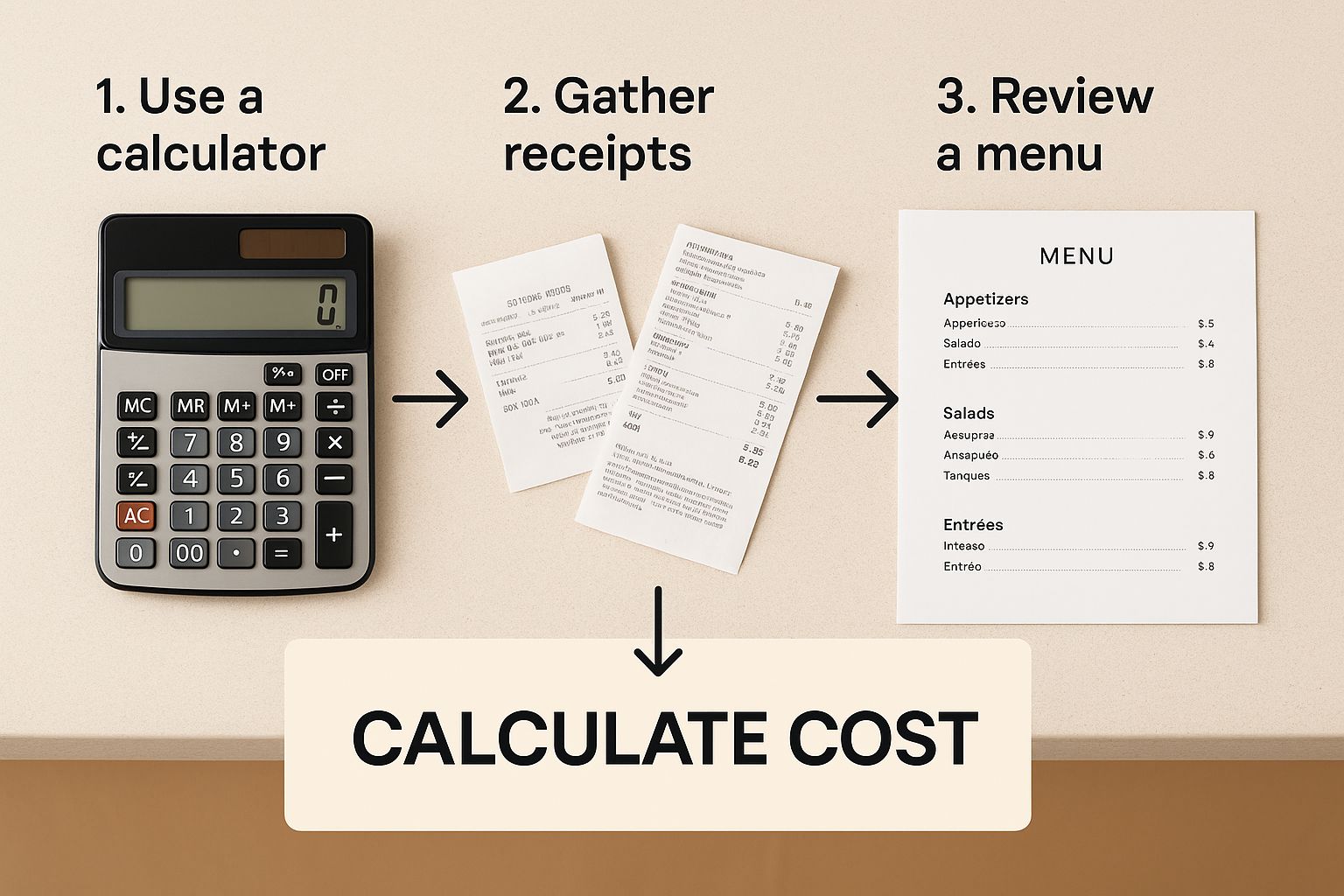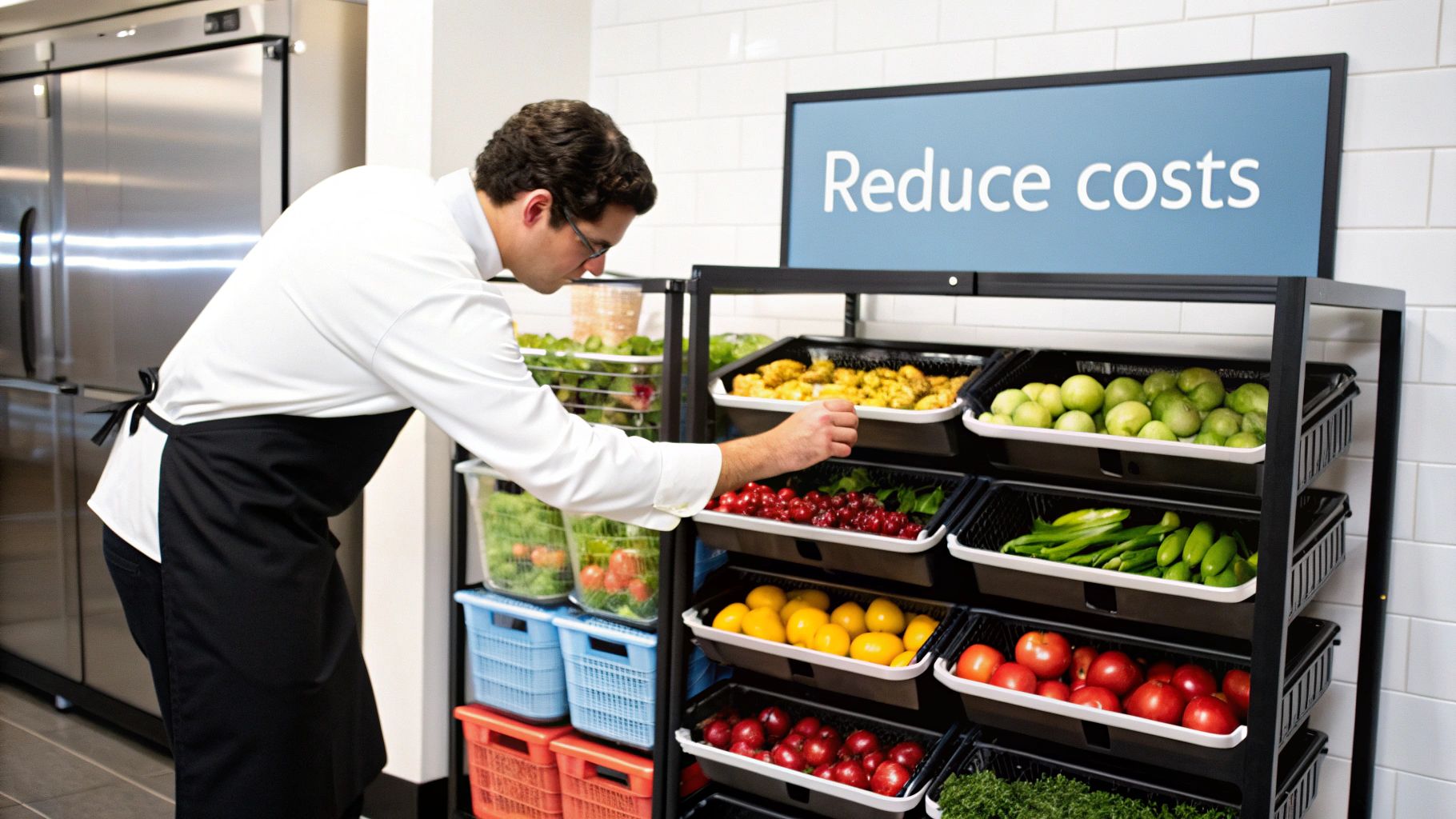
Pizza Food Cost Percentage Calculation Guide
Share
Knowing your food cost percentage is the single most important thing you can do for your pizzeria's bottom line. It’s a straightforward calculation that tells you exactly how much you're spending on ingredients for every dollar you make from the pies that slide off your pizza prep table.
This isn't just some number for your accountant to look at once a quarter. It’s your weekly, even daily, guide to the financial health of your pizza shop.
Why Food Cost Is Your Pizzeria's Most Critical Metric

Let's be real. Running a pizzeria isn't just about crafting the perfect pie; it’s about managing your numbers so you can stay in business. Your food cost percentage is the most powerful tool you have for understanding that financial reality. It’s the direct link between the ingredients on your pizza prep table and the money in your bank account.
Don't mistake this for complex financial jargon. A tiny shift in this one number can be the difference between struggling to make payroll and having a thriving pizza business.
For most pizzerias in the U.S., food cost percentages hover somewhere between 28% and 35%. But things have gotten tricky lately. Supply chain hiccups and global events caused food prices to jump by as much as 11.4% in 2022 alone, which put a massive strain on every pizza operator's budget.
Think of it this way: for every dollar that comes in, about 30 cents goes right back out the door for cheese, flour, and pepperoni. The game is won or lost in how well you control those 30 cents on your pizza prep table.
Getting a handle on your food cost starts with solid financial habits. For any pizzeria owner, that means mastering the bookkeeping basics for small business first.
Ultimately, tracking this number gives you a clear window into how your shop is really running. It answers critical questions like:
- Are my pizza prices actually profitable?
- How much cheese is hitting the floor instead of a pizza?
- Is my inventory management efficient or wasteful?
By keeping a close eye on this metric every single week, you can start making smarter, data-backed decisions that put more money in your pocket.
The Real Formula for Food Cost Percentage Calculation
If you want to get a real handle on your pizzeria's finances, you have to move beyond just guessing. The key is nailing down your food cost percentage calculation. It's the only reliable way to see what your ingredients—from the flour for your dough to the last shred of mozzarella—are actually costing you over a specific time.
The formula itself is straightforward: (Beginning Inventory + Purchases – Ending Inventory) / Total Food Sales.
But don't just glance at it like some abstract math problem. This formula is a direct reflection of what's happening on your pizza prep table and in your walk-in. It’s designed to tell you the cost of the food you actually used, not just the food you bought.

As you can see, getting this right hinges entirely on accurate inventory counts and sales numbers. Garbage in, garbage out.
Breaking Down the Numbers
Let's walk through a real-world pizzeria scenario. Say you want to track your most expensive item—mozzarella cheese—for one week to see where your money is going.
- Beginning Inventory: On Monday morning, you count up your cheese and find you have $1,000 worth on hand.
- Purchases: Your mid-week delivery drops off another $500 worth of mozzarella.
- Ending Inventory: Come Sunday night, after the last pizza goes out, you have $700 worth of cheese left.
Now, we can plug those numbers into the first part of the formula (Beginning Inventory + Purchases – Ending Inventory) to find your Cost of Goods Sold (COGS) for just the mozzarella: $1,000 + $500 – $700 = $800.
That $800 is the magic number. It means you actually used $800 worth of cheese to make pizzas that week.
This COGS figure is the most crucial part of the food cost percentage calculation. It represents the actual value of inventory that left your shelves and was turned into sellable pizzas.
Keeping a close eye on this is more important than ever. With U.S. consumer food prices jumping by 23.6% between 2020 and 2024, your pizza ingredient costs are a constantly moving target.
Once you have the COGS for all your ingredients and your total food sales for that same week, you can finally calculate an accurate percentage. This number is your guide for making smarter calls on everything from menu pricing to inventory orders. To see the bigger picture of how this number fits into your shop's health, try plugging it into our restaurant profit margin calculator.
How to Accurately Cost a Single Pepperoni Pizza
That big-picture food cost percentage is great for a bird's-eye view, but real profitability is built one pizza at a time on your pizza prep table. This is where the rubber meets the road. Breaking down the cost of a single, core menu item—like a classic 14-inch pepperoni pizza—is probably the most practical thing you can do for your bottom line.
This process is called creating a recipe cost card, and it connects the bulk prices you pay your suppliers directly to the finished pizza you hand to a customer. This isn't just a numbers game; it’s how you find out if your menu prices are actually making you money. It also forces you to lock in standard recipes and portion sizes, which is the absolute foundation of cost control in any pizzeria.
Breaking Down Each Ingredient
To get a true plate cost, you have to figure out the price of every single component that goes into that pizza. That means digging deeper than the price on the bag, box, or can and finding the cost per ounce, gram, or slice.
Let’s run the numbers on a standard 14-inch pepperoni pizza.
- Dough Ball: If a 50 lb bag of flour costs you $25.00 and you get 65 12-ounce dough balls out of it, each dough ball costs $0.38 ($25.00 / 65). Simple enough.
- Pizza Sauce: A big #10 can of sauce runs $6.00 and holds 105 ounces. If every pizza gets a 4-ounce ladle of sauce, that one can covers about 26 pizzas (105 / 4). This puts your sauce cost per pizza at a cool $0.23 ($6.00 / 26).
- Mozzarella Cheese: Here's where the money is. A 20 lb case of shredded mozzarella costs $65.00. With 16 ounces per pound, that’s 320 total ounces. If you're putting 7 ounces of cheese on each pie, your cheese cost comes out to $1.42 per pizza (($65.00 / 320 oz) * 7 oz).
- Pepperoni: A 10 lb case costs $45.00 and has roughly 1,600 slices. If your standard is 32 slices per pizza, the pepperoni sets you back $0.90 (($45.00 / 1600 slices) * 32 slices).
There’s no other way to get a real number. Without doing this detailed work, you’re just guessing at your profit margins every time a pizza order comes in.
Assembling the Recipe Cost Card
Now, let's pull all those numbers together to see what one pepperoni pizza truly costs you to make.
This simple table is your source of truth. It breaks down exactly where your money is going for one of your most popular pizzas.
Sample Recipe Cost for a 14-Inch Pepperoni Pizza
| Ingredient | Unit Cost | Portion Size (per Pizza) | Cost per Pizza |
|---|---|---|---|
| Dough Ball | $25.00/bag | 1 (12 oz) ball | $0.38 |
| Pizza Sauce | $6.00/can | 4 oz | $0.23 |
| Mozzarella Cheese | $65.00/case | 7 oz | $1.42 |
| Pepperoni | $45.00/case | 32 slices | $0.90 |
| Total Plate Cost | $2.93 |
With this data in hand, you can see that your total cost to build one large pepperoni pizza is $2.93. Now you can make decisions based on facts, not feelings.
With a total plate cost of $2.93, you now have a hard number to work with. If your target food cost is 30%, you know the absolute minimum menu price for this pizza should be $9.77 ($2.93 / 0.30) just to meet your goal.
This exercise instantly shows you the power of portion control at the pizza prep table. That extra ounce of cheese a new cook keeps adding might seem like no big deal, but at $0.20 per ounce, it bleeds profits over hundreds of pizzas a week. This is what we mean by getting granular—this is your roadmap to smarter pizza pricing and a healthier bottom line.
Common Mistakes That Inflate Your Pizzeria Food Costs

You can have the food cost formula down to a science, but if your day-to-day pizzeria operations are a mess, your numbers will be a fantasy. The real profit leaks aren’t usually found on a spreadsheet; they’re happening right on the pizza prep table, silently draining your bank account.
Many pizzeria owners get so wrapped up in the big picture that they miss these small, constant bleeds. But trust me, identifying and stopping them is the only way to get a true handle on your pizzeria's financial health.
The Silent Profit Killers
I’ve seen it a hundred times: over-portioning is the number one culprit. That "extra handful" of cheese a new cook throws on every pizza feels like a gesture of generosity, but it can easily add up to thousands of dollars in unaccounted-for costs by the end of the year. Portion scoops and scales aren't suggestions—they're non-negotiable tools for survival for any pizzeria.
Waste is a close second, and it often starts at a disorganized pizza prep table. When ingredients aren't held at the right temp or the station is chaotic, spoilage and cross-contamination skyrocket. A messy station means dropped toppings, spilled sauce, and unusable dough. All of that inflates your costs without bringing in a single dollar of pizza revenue.
An accurate food cost percentage is about more than just math. It's a direct reflection of how tight your operational controls are at the pizza prep table. You have to stop waste, theft, and inconsistencies before they ever hit the books.
Beyond what you can see on the floor, a few procedural flaws can be just as damaging for a pizza restaurant.
- Inconsistent Inventory: Rushing your weekly count or "guesstimating" what's in the walk-in will completely torpedo your food cost accuracy. Every count has to be methodical and precise.
- Untracked Comps: Giving away a pizza to make a customer happy is just part of the business. But if that free pie isn't logged as a comp, it just looks like waste or theft in your final numbers.
- Employee Theft: It can be as small as a free soda for a friend or as big as taking home pizza ingredients. Unmonitored employee consumption directly inflates your cost of goods sold, pure and simple.
Plugging these leaks starts with building solid systems and training your team to actually follow them. That means optimizing your kitchen layout with the right pizza prep tables and truly understanding the basics of effective restaurant supply chain management to make sure every ingredient flows smoothly from the delivery truck to the pizza box.
Proven Strategies to Lower Your Food Cost Percentage
Knowing your food cost percentage is one thing. Actually lowering it is how you build a seriously profitable pizzeria. Once you have a reliable number to work with, you can start making targeted changes that directly impact your bottom line—and many of those changes start right at the pizza prep table.
It’s all about small, consistent improvements. You don't have to overhaul your entire pizza operation overnight. The real key is moving from just tracking costs to actively managing them with smart, practical tactics your whole team can get behind.
Optimize Your Pizza Menu and Sourcing
Your menu is your single most powerful sales tool, so you need to engineer it for profit. This means strategically highlighting high-margin, low-cost pizzas—like a classic margherita—over a triple-meat specialty pie loaded with expensive ingredients. Dive into your POS data to see what’s selling best and what’s making you the most money, then tweak your menu layout to gently guide customers toward those more profitable choices.
Your supplier relationships are another goldmine for savings. Don't be afraid to negotiate prices, especially on the high-volume stuff you buy constantly, like cheese and flour.
- Ask for Discounts: See what kind of deals you can get for buying in bulk or paying your invoices early. A few percentage points can add up fast.
- Lock in Prices: When you see market prices dip for key pizza ingredients, ask your supplier if you can lock in a contract rate for a few months.
This kind of proactive sourcing creates a buffer against the sudden price hikes that can wreck your margins. It's also worth remembering the global picture. While US households spent about 6.4% of their income on food back in 2015, families in other countries can spend over 45%. It's a stark reminder of how much localized supply chains and smart sourcing matter for your pizzeria. You can see more on these global food price variances on yara.com.
Master Your Pizza Prep Table Workflow
Waste is the silent killer of profit in any pizzeria, and the pizza prep table is ground zero. It’s not enough to just track the numbers; you have to put real strategies in place for reducing food waste in restaurants.
A strict First-In, First-Out (FIFO) system for every single pizza ingredient is non-negotiable. This simple habit of using your older stock before cracking open the new stuff prevents spoilage and stops you from literally throwing money in the trash can.
An organized pizza prep table with clearly labeled ingredient bins, portioning tools at the ready, and a clean workflow isn't just for show—it's a profit-saving machine. It minimizes cross-contamination, cuts down on dropped toppings, and speeds up your pizza service times.
Ultimately, this is the kind of professional discipline that separates the average pizzerias from the highly successful ones. For a deeper dive, check out our detailed guide on reducing food waste in restaurants for more tips you can put into action today.
Common Questions About Pizzeria Food Costs
Once you have the formulas down, the real-world questions always start popping up. Let’s tackle some of the most common challenges pizzeria owners run into when trying to get a handle on their food cost percentage.
How Often Should I Be Calculating My Food Costs?
For the tightest control over your numbers, you should be running a food cost percentage calculation every single week. It might sound like a lot, but this is how you catch problems early.
A weekly check lets you spot a supplier price hike on cheese or a spike in waste at the pizza prep table before it has a chance to wipe out an entire month's profit. While a full, wall-to-wall physical inventory every week is the gold standard, many savvy pizza operators track their big-ticket items—like cheese and pepperoni—daily or a few times a week. They then save the full count for a monthly baseline to keep everything honest.
What’s a Good Food Cost for a Pizzeria?
Most successful pizzerias live in the 25% to 32% food cost range. Where you land depends entirely on your concept.
A shop slinging pies with premium imported mozzarella and artisanal pepperoni might run a higher percentage, but they can justify it with higher menu prices and a different customer base. The real goal is finding the sweet spot for your pizza brand—that perfect number that covers all your ingredients and still leaves a healthy profit margin.
If you see your food cost percentage creeping up, there are three places to look immediately: your pizza prep table, your trash cans, and your inventory sheets. Check for proper portioning, excessive waste, and simple math errors. More often than not, the problem is hiding in one of those three spots.
Ready to build a more efficient and profitable pizzeria? At Pizza Prep Table, we provide the high-quality, NSF-compliant refrigeration and workstations you need to master your workflow. Explore our durable pizza prep tables and find the perfect fit for your operation.
